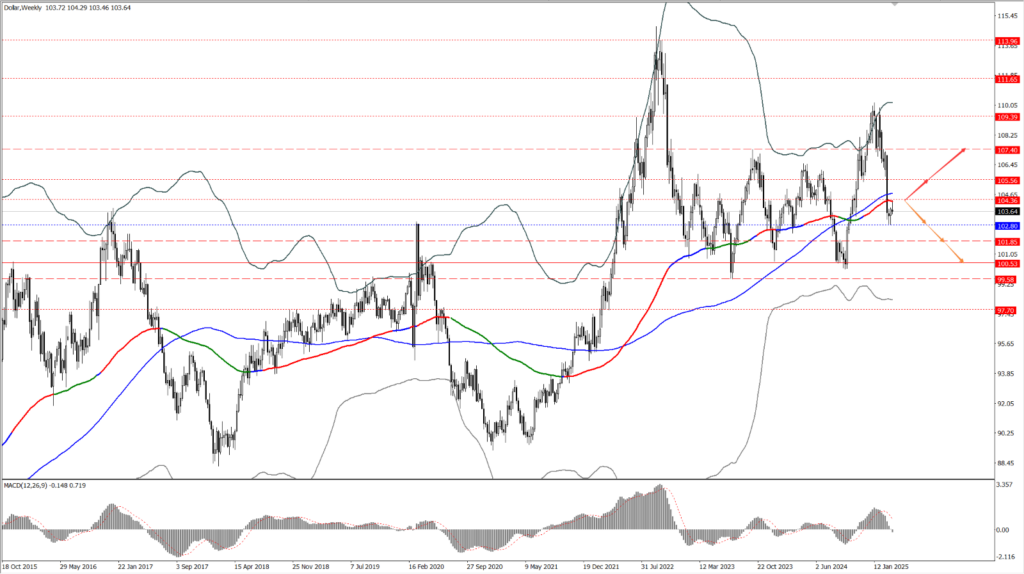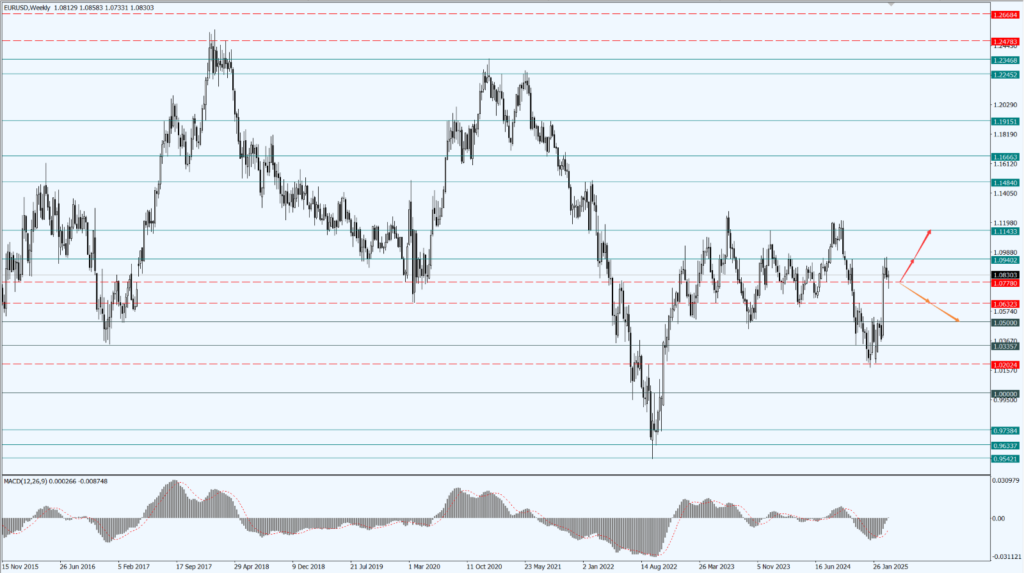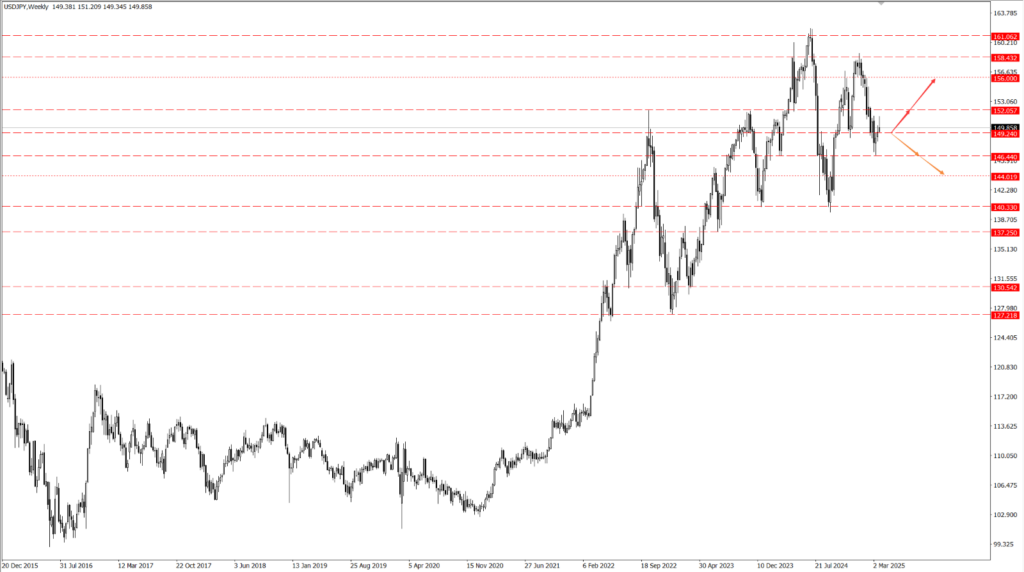US Dollar Index
Last week, Trump announced “reciprocal tariffs” that exceeded market expectations. These tariffs combine a “carpet-style” approach with a “one country, one rate” system, covering more than 60 major economies. The implementation of these reciprocal tariffs has not alleviated uncertainty but has instead heightened concerns about global economic development.
Firstly, the broad scope and significant scale of the tariffs will have a major impact on both the US and global economies. How will countries respond after the tariffs are imposed? Will they retaliate or endure? If retaliatory measures are taken, it could escalate into a full-blown tariff war, exerting further downward pressure on the global economy—a risk worth monitoring.
The US Dollar Index (DXY) exhibited a “V-shaped” reversal last week. The trade war impacted liquidity, but March non-farm payrolls added 228,000 jobs, reflecting economic resilience. However, Fed Chair Powell warned that tariffs could lead to a scenario of “rising inflation alongside slowing growth.” Market expectations for a June rate cut dropped from 70% to 50%, as the effects of reciprocal tariffs continue to unfold and remain under observation.

Last week, the DXY faced pressure near the key level of 104.36, dropping sharply before stabilizing and rebounding above 100.53. This indicates that bulls are fiercely defending the round-number level of 100, making it the last line of defense for the DXY in the near term.
This week, focus on the bull-bear threshold at 101.85:
- If the DXY trades above 101.85, monitor the strength and extent of the subsequent rebound, with resistance levels at 104.36 and 105.56.
- If the DXY faces downward pressure, especially after failing to break 104.36, and decisively falls below 101.85, it will open further downside potential, with support levels at 100.53 and 99.58 to watch.
EUR/USD
Last week, the European Central Bank (ECB) took a hawkish stance, stating it would not consider rate cuts until inflation returns to 2%. Market expectations for ECB rate cuts this year dropped from four to three. Meanwhile, inflation data diverged between the US and Europe: the Eurozone’s March CPI rose to 2.9% year-over-year, while the US core PCE fell to 2.8%. This monetary policy divergence supported the euro.

Last week, EUR/USD stabilized above the bull-bear threshold of 1.0778, surged significantly, and reached the key level of 1.1143 before pulling back with a long upper shadow. This suggests a tug-of-war between buyers at the bottom and sellers at the top within the 1.0778 to 1.1143 range.
- If bears break through the 1.0778 level defended by bulls, it will open further downside potential.
- If bulls break through the 1.1143 level defended by bears, it will open further upside potential.
This week, focus on the bull-bear threshold at 1.0940:
- If EUR/USD stabilizes above 1.0940, watch resistance levels at 1.1143 and 1.1484, with particular attention to the 1.1143 resistance.
- If EUR/USD faces downward pressure and decisively falls below 1.0940, monitor support levels at 1.0778 and 1.0632, especially the support near 1.0778.
USD/JPY
Last week, USD/JPY recorded its largest decline since early February. A sell-off in risk assets, with global stock markets losing over $3 trillion in market value, drove a return to the yen’s traditional safe-haven status. The Bank of Japan (BOJ) made slight policy adjustments, and market rumors suggest the BOJ may reduce its bond purchases. The 10-year Japanese government bond yield rose to 0.85%, and the unwinding of carry trades further fueled yen appreciation.

Last week, USD/JPY broke below the bull-bear threshold of 149.24, dropped sharply, and then stabilized and rebounded above 144.01. This week, focus on the bull-bear threshold at 146.44:
- If USD/JPY stabilizes above 146.44, monitor the strength and extent of the subsequent rebound, with resistance levels at 149.24 and 152.05. Pay close attention to the 149.24 resistance—a break above this level will open further upside potential for USD/JPY.
- If USD/JPY decisively falls below 146.44, it will retest the 144.01 support level. A break below 144.01 will open further downside potential, with the 140.33 level as the next key support and a critical bull-bear dividing line in the near term.
Forward Looking Statement Disclaimer
This document contains forward-looking statements, which can generally be identified by the words “expects,” “believes,” “continues,” “may,” “estimates,” “anticipates,” “hopes,” “intends,” “plans,” “potential,” “predicts,” “should,” “will,” or similar expressions. Such statements are based on CG FinTech’s current expectations and assumptions, but actual results could differ materially from those anticipated due to a number of risks and uncertainties. CG FinTech does not guarantee the accuracy or completeness of these statements and undertakes no obligation to update or revise any forward-looking statements.
Disclaimer
The information provided herein is for informational purposes only and does not constitute an offer or solicitation to buy or sell any financial instruments. Trading Contracts for Difference (CFDs) and foreign exchange (forex) carries a high level of risk and may not be suitable for all investors. It is important to fully understand the risks involved and seek independent financial advice if necessary.

Leave a Reply